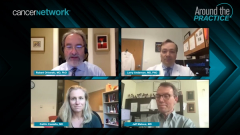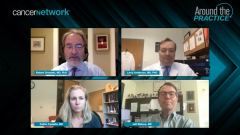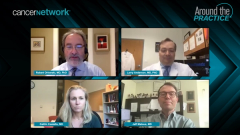
Transplant-Ineligible MM: Reinitiating Therapy
Triggers that may lead a hematologist/oncologist to consider reinstituting therapy for a patient with transplant-ineligible multiple myeloma (MM) who received prior therapy but was not treated to progression.
Episodes in this series

Robert Orlowski, MD, PhD: Let’s go to the next polling question. If you do not treat to progression—even though everybody voted to treat until progression—what would be your trigger for restarting therapy? Would it be return of symptoms, worsening of symptoms, changes in routine labs, MRD [minimal residual disease], or other? Let’s have [the audience] vote, and Larry, let’s start with you on this one.
Larry Anderson, MD, PhD: It depends on how bad their disease was and what symptoms they were having before their treatment started. If it’s someone who had aggressive disease and they’re now having early biochemical progression, I’ll probably change their therapy before it causes symptoms or new problems. If it’s someone that had elevated light chain ratio or mild anemia, that’s someone you could probably watch longer and monitor their biochemical progression longer, or maybe make some simple changes, or add back some dexamethasone, or mild things like that rather than switching gears completely. In general, I would say based on the labs without necessarily waiting for new symptoms, but it depends on the patient.
Robert Orlowski, MD, PhD: Caitlin, one nuance that probably wasn’t picked up by this poll. What about in terms of laboratory changes? Does the pace of the change in the laboratory values matter?
Caitlin Costello, MD: Absolutely. First, what we are desperately trying to avoid is clinical relapse. We are trying to intervene as best as possible before a new bone lesion or before they become anemic. Trying to find that magical point to intervene is the art that Jeff mentioned before. Patients regularly ask me, “What is your cutoff before you say enough is enough?” I don’t have a cutoff number because some people will take 2 years or longer to get to that cutoff. But you’re right, Bob, there is a rate of progression that matters. I don’t like to compare it to other diseases, but the CLL [chronic lymphocytic leukemia] doubling time rings a bell to see if you see something that’s doubling in some period of time and that knot in your stomach starts kicking in. There is a gestalt here that makes you, at some point, say enough is enough. I don’t have a cutoff, but if I know someone is starting to pick up their pace, they have high-risk disease. I’ve seen how their disease has progressed or relapsed in the past. I’m going to be more personalized in my approach.
Robert Orlowski, MD, PhD: Jeff, any other thoughts or responses to the results of the polling in front of you?
Jeff Matous, MD: If I have a patient who’s on what I call a treatment holiday, patients like treatment holidays. They like being off therapy for a little bit. If they’re relapsing, I do more testing when I don’t want to treat them than when I know I need to treat them. I’ll do an advanced bone imaging study and just reassure us, “Hey, there’s no bone lesions here. Your skeletal MRI [magnetic resonance imaging], or your CT [computed tomography], or your PET [positron emission tomography] scan look OK. We’re OK sitting on your disease right now.” I use a lot of that in my practice. All of us draw lines in the sand. We say, “Hey, we don’t want you to get back to where you were.” Looking at the results here, it’s typical of what happens in the real world, which is that some of us draw lines in the sand with our labs and then reinstitute therapy, and some of us wait for anemia, fatigue, more proteinuria, or whatever else to come on before we throw in therapy. I tend to try to do what Caitlin did, which is try to head people off at the pass.
Robert Orlowski, MD, PhD: Very good. Larry, it looks like a couple people voted for MRD. What do you think about using MRD testing as a reason to change treatments at this time? Are we there yet?
Larry Anderson, MD, PhD: We’re not quite there yet. We don’t have enough data to use that yet. Certainly it makes you nervous and you might do closer intervals of testing if someone is turned from negative to positive and just watching them closely, but I don’t know that we necessarily know that means that we have the reason to change their therapy yet.
Robert Orlowski, MD, PhD: Very good. Let’s go to our next polling question. If you do not treat to progression—again, most people said that they would—but how would you reinitiate therapy? For the sake of the argument, let’s say the patient had toxicity and needed a treatment holiday. Certainly, holidays are always good to be able to give patients. In this case, would you rechallenge with a maintenance regimen, restart the initial regimen, start a new regimen, or do other? While we’re getting the votes, Caitlin, do you want to tell us what your thoughts are?
Caitlin Costello, MD: Can I say yes? Because this is how myeloma doctors treat these days. It does depend. You can have patients, fortunately, who take drug holiday, that holiday that was supposed to be 4 months suddenly turned into a year, and what a wonderful problem that is. No. 1, what toxicities do they have? No. 2, how long does it last for? No. 3, are they still sensitive to it? If something previously worked and you stopped it, not because it stopped working, it is certainly reasonable to restart it again. If someone has had a prolonged time off and they decided to stop, the better, try it again.
Robert Orlowski, MD, PhD: Excellent. Jeff, any other thoughts on that? It looks like our audience is split between options B and C.
Jeff Matous, MD: Yes, I totally get that. I tend not to be what I call a “tweaker,” that is if you progressed on something, just making a mild modification to it to see how it goes, but it also depends on what you use the first time around and whether you got something better the second time around. If you gave somebody Rd [lenalidomide plus dexamethasone] and they progressed, then you may have dara/pom/dex [daratumumab, pomalidomide, dexamethasone], which is a great second-line therapy and is well tolerated. You can give it to older people as well. It depends on what you gave them before.
Robert Orlowski, MD, PhD: Larry, what are your thoughts on that?
Larry Anderson, MD, PhD: I would echo the same. It comes back to the same issue, too, of what’s the doubling time? What’s the rate of progression? Are they symptomatic? If they’re rapidly doubling or becoming symptomatic, I would go to more of a triplet, a reinduction type thing, especially if it’s been a while off therapy. If it’s just meeting criteria for progression based on biochemical, then I would typically add back more of their maintenance that they had stopped several months ago and see if that makes any difference. That’s the art, and just figuring out which patients can have a better outcome with these different strategies.
Transcript edited for clarity.
Newsletter
Stay up to date on recent advances in the multidisciplinary approach to cancer.

























































































